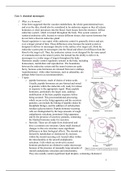Case 1: chemical messengers
1. What is a hormone?
- It has been suggested that the vascular endothelium, the whole gastrointestinal tract,
and even the skin, should also be considered to be endocrine organs as they all release
hormones or -their precursors into the blood. Such tissues form the extensive `diffuse
endocrine system', which is located throughout the body. This system consists of
scattered endocrine cells, located in various different tissues, that secrete hormones but
do not form a discrete endocrine gland.
- Neural regulation is very rapid, while endocrine control is generally slower and acts
over a longer period of time. These differences arise because the neural system is
designed to deliver its messenger directly to the surface of its target cell, while the
endocrine system puts its messengers into the blood and allows for diffusion from the
blood to the target cell. Thus, the endocrine system is not designed for the same speed
of communication as the neural system, but instead has the ability to deliver its
messengers to a wider range of targets throughout the body.
Hormones usually control regulatory systems in the body, including
homeostasis, metabolism and reproduction. The boundaries
between the endocrine system and the neural system are quite
fuzzy, because some hormones are released from nerve endings,
'neurohormones', while other hormones, such as adrenaline, are
perhaps better known as neurotransmitters.
- 3 types:
o peptide hormones, made of chains of amino acids.
Usually, peptide hormones are pre-formed and stored
in granules within the endocrine cell, ready for release
in response to the appropriate signal. Many peptide
hormones, particularly the larger ones, undergo
modification of the basic peptide sequence before
being secreted. This post-translational processing,
which occurs in the Golgi apparatus and the secretory
granules, can include the linking of peptide chains by
disulphide bridges, and the addition of carbohydrate
residues (glycosylation). Peptide hormone-secreting
cells are distinguished by the large amounts of rough
endoplasmic reticulum, prominent Golgi apparatus
and by the presence of secretory granules, containing
the finished hormone ready for secretion.
o Steroids: These are all made from cholesterol and
have a common core structure. Quite small chemical
changes to this core structure cause significant
differences in their biological effects. The steroids are
formed by metabolism of cholesterol by enzymes
within the steroid-secreting cell, located either within
the mitochondria or the smooth endoplasmic
reticulum. Cells which are involved in steroid
hormone production are distinctive under microscopy
because of the presence of unusually large amounts of
smooth endoplasmic reticulum and mitochondria.
They also usually contain significant lipid droplets, containing cholesterol
1
, esters, as steroid-secreting cells store the precursor to
hormone synthesis rather than the finished product.
o those derived from amino acids.
- Peptide hormones and catecholamines (DA, NE, Adrenaline),
being generally quite water-soluble, dissolve readily in plasma,
the fluid component of the blood, but cannot enter the target cell,
so interact with receptors on the cell surface. The lipophilic
steroid and thyroid hormones, on the other hand, dissolve poorly
in plasma and are mostly transported in blood bound to carrier
proteins, but readily enter cells to interact with cytoplasmic or nuclear receptors.
While peptide hormones and catecholamines are synthesized then stored in granules in
the cells to be released as soon as they are needed, steroid-secreting cells keep a store
of cholesterol, the substrate for steroid biosynthesis, rather than the final steroid
product. This is largely a matter of practicality as the steroid hormones, being lipid
soluble, are difficult to store, whereas cholesterol can be esterified and stored easily.
As a consequence of their small and lipophilic nature, steroid hormones do not require
a specific secretory mechanism: they simply diffuse across the plasma membrane and
out of the cell down concentration gradient. Peptide hormones, on the other hand,
need a specific secretory mechanism. when they are used therapeutically, steroid
hormones and thyroid hormones are orally active, whereas most peptide hormones
(such as insulin) must be injected, to avoid being inactivated by digestive enzymes.
-
- Classically, hormones travel from the cells where they are
made, in the bloodstream, to reach the cells where they act.
But some hormones also act locally, on different cell types
in the tissue where they are produced. This is termed a
'paracrine' effect. Other hormones act directly on the same
type of cell that secretes them. This is termed an 'autocrine'
action. Hormones. May have a mixture of different types of
action.
- Hormones circulate in blood in very low concentrations.
Although some hormones mostly the peptide hormones, are
freely water-soluble, the steroid and thyroid hormones are
not so soluble, and need to be transported in blood bound to
a carrier or binding protein. Binding proteins have 3
functions: increase solubility of the hormone in blood, create
a readily accessible reserve of hormone in blood, increase
biological half-life of the hormone by protecting it from
metabolism and excretion. Peptide hormones mainly
metabolized following binding to a receptor in the target
cell. The hormone-receptor complex is internalized and the
2




